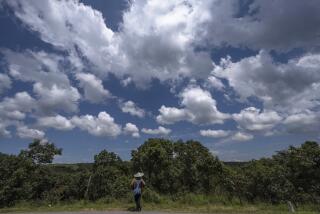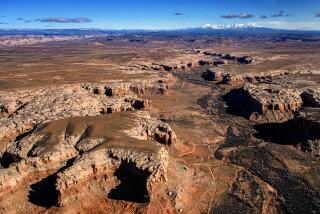Native Americans Seeking to Spare Wandering Bison
GARDINER, Mont. — Witnessing a ritual not seen for a century, about a hundred members of American Indian tribes gathered Saturday on a pilgrimage seeking an end to the killing of bison that wander out of Yellowstone National Park.
Those who made the pilgrimage are bearing witness to the sacred relationship between the buffalo and Native Americans, said Joseph Chasing Horse, a Lakota Sioux leader who helped organize the event.
For many American Indians, eating the flesh of bison is comparable in religious significance with Holy Communion among Christians, said Chasing Horse, who led the group.
For Montana cattle ranchers, however, it’s a matter of killing animals they fear will carry disease to their herds.
By Saturday, the pilgrims had finished a journey of about 500 miles over 20 days, many on foot or on horseback, from Rapid City in the Black Hills of South Dakota to this gateway town at the north entrance of Yellowstone.
In a two-hour ceremony Saturday on a wind-swept, muddy field, just inside a massive stone arch that marks the entrance to the country’s oldest national park, the participants prayed and sang.
“Long ago, the buffalo gave his blood for us. Today, we give our blood for him,” Chasing Horse said.
Then, Gary Silk, a Lakota activist from South Dakota, removed his shirt. Others thrust sharp sticks through his skin in two places just below the shoulder blades. A rope was attached to each, and a ceremonial buffalo skull was tied to the other end of each rope.
Silk then danced slow circles around the gathering of about 250 Native Americans and other spectators, as blood ran down his back.
Then as another man sat on the skulls, Silk took hold of a horse’s tail, and the horse pulled him away from the skulls, tearing the sticks free from Silk’s flesh.
The ritual has not been performed in more than 100 years and had never before been seen by white people, Chasing Horse said.
Joining the Lakota Sioux were representatives of tribes from as far away as New York and Arizona, including the Algonquin, Apache, Assiniboine, Blackfeet, Crow, Navajo, Nez Perce, Northern Cheyenne, Southern Ute and Tuscarora.
More to Read
Sign up for Essential California
The most important California stories and recommendations in your inbox every morning.
You may occasionally receive promotional content from the Los Angeles Times.










